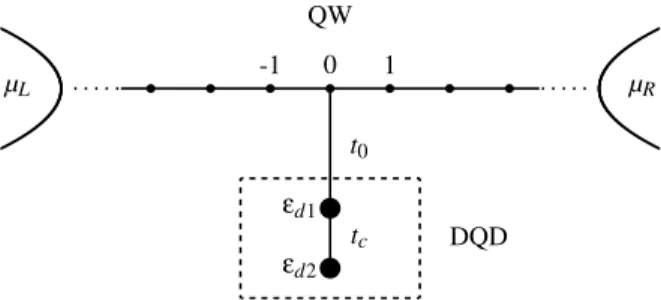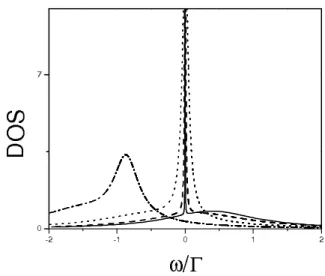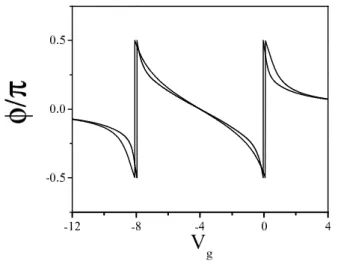820 Brazilian Journal of Physics, vol. 36, no. 3B, September, 2006
Kondo and Fano Effect in Side Attached Double Quantum-Dot Molecule
Gustavo A. Lara∗, Pedro A. Orellana∗, Julio M. Y´a˜nez∗, and Enrique V. Anda† ∗ Departamento de F´ısica, Universidad de Antofagasta, Casilla 170, Antofagasta, Chile ∗Departamento de F´ısica, Universidad Cat´olica del Norte, Casilla 1280, Antofagasta, Chile
†Departamento de F´ısica, P. U. Cat´olica do Rio de Janeiro, C.P. 38071-970, Rio de Janeiro, RJ, Brazil
Received on 8 December, 2005
Electron tunneling through a double quantum dot molecule side attached to a quantum wire, in the Kondo regime, is studied. The mean-field finite-Uslave-boson formalism is used to obtain the solution of the problem. We investigate the many body molecular Kondo state and its interplay with the inter-dot antiferromagnetic correlation as a function of the parameters of the system.
Keywords: Quantum dots; Kondo effect; Fano effect
I. INTRODUCTION
The Kondo effect in quantum dots (QDs) has been ex-tensively studied in the last years [1]. The QDs allow to study systematically the quantum-coherence many-body Kondo state, due to the possibility of continuous tuning the relevant parameters governing the properties of this state, in equilibrium and non-equilibrium situations. Recently Kondo effect has been studied in double quantum dot molecule in se-ries [2, 3]. This system allows the study of the many body molecular Kondo states in equilibrium and non-equilibrium situation. The type of coupling between the QDs determines the character of the electronic states and the transport prop-erties of the artificial molecule. In the tunneling regime, the electronics states are extended across the entire system and form a coherent state based on the bonding or anti-bonding levels of the QDs.
An alternative configuration consists of a side-coupled QDs attached to a perfect quantum wire (QW). This structure is reminiscent of T-shaped quantum wave guides known as elec-tron stub tuners [4]. In this case, the QDs act as scattering centers in close analogy with the traditional Kondo effect [5]. Recent electron transport experiments showed that Kondo and Fano resonances occurs simultaneously [6]. Multiple scattering of traveling electronic waves on a localized mag-netic state are crucial for a formation of both resonances. The condition for the Fano resonance [7] is the existence of two scattering channels: a discrete level and a broad continuum band [8, 9].
In this work we study the transport properties of a dou-ble quantum dot molecule side attached to a quantum wire in the Kondo regimen. We use the finite-Uslave boson mean-field approach which was initially developed by Kotliar and Ruckenstein [10] and used later by Bing Dong and X. L. Lei to study the transport through coupled double quantum dots connected to leads [11], which enforces the correspondence between the impurity fermions and the auxiliary fermions to a mean-field level to release theU=∞restriction. In double quantum dot molecules this approach allows one to treat both dot-lead coupling and the interdot tunneling nonperturbatively at an arbitrary strengths of the Coulomb correlationU, and thus an antiferromagnetic exchange coupling parameter
ap-pears naturally [11]. We investigate the many body molecular Kondo ground state and the competing singlet ground state that results from the anti-ferromagnetic correlation between the dots, as a function of the parameters of the system. In the Kondo regime, each dot results to have its own Kondo tem-perature as a consequence of their different connections to the conduction electrons.
✈ ✈ εd1
εd2 t0
tc -1 0 1
QW
DQD
µL . . . r r r r r r r . . . µR
FIG. 1: Scheme of double quantum dot (DQD) attached to a lead (perfect quantum wire (QW)). The QW is coupled to the left (L) and right (R).
II. MODEL
Let us consider a double quantum dot (DQD) side coupled to a perfect quantum wire (QW) (see Fig. 1). We adopt the two-fold Anderson Hamiltonian. Each dot has a single level εdi(withi=1,2), intra-dot Coulomb repulsionU, is coupled to each other with inter-dot tunneling couplingtc. The side attached double quantum-dot is coupled to the QW with cou-plingt0. The QW has a site energyεi,σand a hopping para-metert.
Gustavo A. Lara et al. 821
H=−t
∑
i,σ ³c†i,σci+1,σ+H.c. ´
−
∑
σ ˜ t0,σ
³
c†0,σf1,σ+H.c. ´
+
2
∑
i=1∑
σ˜
εdi,σfi†,σfi,σ−
∑
σ˜ tc,σ
³
f1†,σf2,σ+H.c. ´
(1)
+
2
∑
i=1(
U di2+λ(i1)¡
p2i,↑+p2i,↓+e2i +di2−1¢−
∑
σ λ(i,σ2)¡
p2i,σ+d2i¢ )
, (2)
wherec†i,σ(ci,σ) is the creation (annihilation) operator of an electron with spinσin thei-th site on quantum wire; fi†,σ(fi,σ) is the creation (annihilation) operator of an electron with spin σin the i-th QD, ˜εdi,σ=εdi+λ2i,σ, ˜t0,σ=t0hZ˜1,σi, and ˜tc,σ=
tchZ˜1,σZ˜2,σi, and we setεi,σ=0 in the QW. The operator ˜Zi,σ is chosen to reproduce the correctU→0 limit in the mean field approximation,
˜ Zi,σ=
³
1−di†di−p†i,σpi,σ ´−1/2³
e†ipi,σ+p†i,−σdi ´ ³
1−e†iei−p†i,−σpi,−σ ´−1/2
. (3)
The constraint, i.e., the completeness relation ∑σp†i,σpi,σ+ b†ibi+di†di=1 and the condition for the correspondence be-tween fermions and bosons fi†,σfi,σ= pi†,σpi,σ+d†idi, have been incorporated with Lagrange multipliersλ(i1)andλ(i,σ2)into the Hamiltonian. We use the mean-field approximation in which all the boson operators are replaced by their expecta-tion value. As we work at zero temperature these expectaexpecta-tion values and the Lagrange multipliers are then determined by minimization of the energy with respect to these variables.
We resolve the problem using the method developed in Ref[3]. Resolving the equations of motion, we find the trans-mission amplitude,
τ= (ω−ε−˜ )(ω−ε˜+) (ω−ε˜−)(ω−˜ε+) +i(ω−ε˜d2)Γ˜
, (4)
where the renormalized bonding and anti-bonding
energies (˜ε±) are defined by ε±˜ = (˜εd1 +εd2˜ )/2 ±
p
(εd1˜ +εd2˜ )/2)2+t˜2
c and ˜Γ = π˜t02ρ0(ω) is the renor-malized coupling between the double quantum-dot and the leads of density of statesρ0(ω). The transmission amplitude can be written in the polar form as,τ=|τ|eiφ, whereφis the transmission phase and it is given by,
φ=tan−1 µℑτ
ℜτ ¶
=tan−1
· −(ω−εd2˜ )Γ˜
(ω−ε−˜ )(ω−ε˜+)
¸
. (5)
The transmission probability isT=|τ|2,
T(ω) = [(ω−ε−˜ )(ω−ε˜+)]
2
[(ω−ε−˜ )(ω−ε˜+)]2+ [(ω−εd2˜ )Γ˜]2
. (6)
Moreover we can obtain the density of states of the quantum dots system,
ρ(ω) =1
π
˜
Γ(ω−εd2˜ )2
[(ω−ε−˜ )(ω−ε˜+)]2+ [(ω−˜εd2)Γ˜]2 +1
π
˜ Γ˜tc2
[(ω−ε−˜ )(ω−ε˜+)]2+ [(ω−εd2˜ )Γ˜]2
. (7)
III. RESULTS
We take typical values for the parameters that define the system,µ=0,t=25Γ,t0=7.07Γ, whereΓ=πt02ρ0(0).
We consider first the situation where the two dots local state
energies are varied simultaneously by a gate voltageVg, i.e. εd1=εd2=Vg.
The transmission probabilityT is displayed in Figure 2 for various values ofU and two values oftc. The transmission probability always reaches zero atω=ε−˜ and ˜ε+and a
822 Brazilian Journal of Physics, vol. 36, no. 3B, September, 2006
FIG. 2: Transmission spectrum forV1g=V2g=Vg=−3Γ,tc=0.5Γ (solid line) andtc=Γ(dashed line), for various values of the on site energyU, a)U=2Γ, b)U=4Γ, c)U=8Γand d)U=16Γ.
between the Kondo effect and the inter-dot anti-ferromagnetic correlation. IncreasingU, a sharp feature develops close to the Fermi energy (ω=0), indicating the appearance of a Kondo resonance. We can see that this process is more rapidly de-fined for the case wheretc=0.5Γthan fortc=Γ. This behav-ior is due to the anti-ferromagnetic interaction between the spins of the dots, proportional totc2/U[11], that destroys the Kondo effect when it is greater than the Kondo temperature creating a singlet ground state for the dot molecule.
ForU sufficiently large the transmission can be written approximately as the superposition of two Fano-Kondo line shapes, one of them has zeroqfactor,
T(ω)≈(ε
′+q′)2
(ε′)2+1 +
(ε′′+q′′)2
(ε′′)2+1 , (8)
whereε′= (ω−εd2˜ )/∆,˜ q′= (εd2˜ −ε−˜ )/∆,˜ ε′′= (ω−ε˜+)/Γ
andq′′=0, with ˜∆=t˜c2/Γ.˜
The DOS of the quantum-dot molecule give us a better un-derstanding of the transport properties of the system. The DOS is shown in Fig. 3 for various values ofU, for the case tc=0.5, where the Kondo spin correlation is dominant over the anti-ferromagnetic one. We can observe the superposition of a narrow and a broad Kondo peak with widths ˜∆ and ˜Γ respectively. In fact, the DOS can be written as the superposi-tion of two Lorentzian,
ρ(ω)≈1
π
˜ Γ
(ω−ε˜+)2+Γ˜2 +1
π
˜ ∆
(ω−εd2˜ )2+∆˜2. (9)
As it can be seen from the figure there is no Kondo peak forU=2Γ, as it should because in this case the QDs are with two electrons each.
In order to confirm the destructive effect of anti-ferromagnetism on the Kondo regime, we display in the inset of the figure the DOS of the DQD for the same parameters as before but withtc=Γ. The DOS shows two peaks at the bond-ing and anti-bondbond-ing energies with no Kondo peak, showbond-ing that for this value oftcanti-ferromagnetism is dominant.
FIG. 3: DOS fortc=0.5Γ,V1g=V2g=−3Γ, for various values of the on site energy,U=16Γ(solid line),U=8Γ(dashed line), U=4Γ(doted line) andU=2Γ(dash-dot line).
On the other hand, we can evaluate the transmission phase at the Fermi energy,
φ(0) =tan−1 ·εd2˜ Γ˜
˜ ε−ε˜+
¸
. (10)
Figure 4 displays the behavior of the transmission phase evaluated at the Fermi energy as a function of the gate voltage, for the on-site energyU=8Γ. For large negativeVgthe en-ergies ˜ε−,˜ε+and ˜εd2are negative andφis negative and tends
to zero. When ˜ε+goes to zero, φtends to−π/2. However,
when ˜ε+becomes positive,φjumps to+π/2. ForVg=U/2, ˜
εd2crosses the Fermi energy and the phase vanishes. At this gate voltage the transmission amplitude evaluated at the Fermi energy is a real number. IncreasingVgwhen ˜ε−approaches to the Fermi energy,φtends to−π/2. At this gate voltage the phase suffers an abrupt change and jumps to+π/2. For large positive values ofVg, the renormalized energies ˜ε−,˜ε+and ˜εd2
are all positive andφis positive and tends to zero.
IV. CONCLUSIONS
Gustavo A. Lara et al. 823
FIG. 4: Transmission phaseφvsVg fortc=0.5Γ(solid line) and tc=Γ, for on site energy,U=8Γ.
the Kondo effect and the physics associated with it. These phenomena have been analyzed as a function of the relevant parameters of the system.
Acknowledgments
G.A.L. and P.A.O. would like to thank financial support Milenio ICM P02-054F, P.A.O. also thanks FONDECYT (grants 1020269 and 7020269), and J.M.Y. and G.A.L. thank U.A. (PEI-1305-04). E.V Anda acknowledges support from the brazilian agencies CNPq (CIAM project) and FAPERJ.
[1] L. I. Glazman, M. ´E. Raikh, JETP Lett. 47 (8) (1988) 452–455; D. Goldhaber-Gordon, H. Shtrikman, D. Mahalu, D. Abusch-Magder, U. Meirav, and M. A. Kastner, Nature 391 (6663), 156 (1998); D. Goldhaber-Gordon, J. G ¨ores, M. A. Kastner, H. Shtrikman, D. Mahalu, and U. Meirav, Phys. Rev. Lett.
81 (23), 5225 (1998); S. M. Cronenwett, T. H. Oosterkamp, and L. P. Kouwenhoven, Science281(5376), 540 (1998). T. K. Ng, P. A. Lee, Phys. Rev. Lett. 61 (15) (1988) 1768—-1771.
[2] A. Georges, Y. Meir, Phys. Rev. Lett.82(17), 3508 (1999); T. Aono, M. Eto, Phys. Rev. B 63 (12), 125327 (2001); H. Jeong, A. M. Chang, and M. R. Melloch, Science
293(5538), 2221 (2001); Q. Feng Sun, H. Guo, Phys. Rev. B
66(15), 155308 (2002).
[3] G. A. Lara, P. A. Orellana, and E. V. Anda, Solid State Comm.
125(3–4), 165 (2003).
[4] P. Debray, O. E. Raichev, P. Vasilopoulos, M. Rahman, R. Per-rin, and W. C. Mitchell, Phys. Rev. B61(16), 10950 (2000). [5] K. Kang, S. Y. Cho, J.-J. Kim, S.-C. Shin, Phys. Rev. B63(11),
113304 (2001); M. E. Torio, K. Hallberg, A. H. Ceccatto, and C. R. Proetto, Phys. Rev. B65(8), 085302 (2002); P. A.
Orel-lana, F. Dom´ınguez-Adame, I. G´omez, and M. L. L. de Gue-vara, Phys. Rev. B 67(8), 085321 (2003); R. Franco, M. S. Figueira, and E. V. Anda, Phys. Rev. B67(15), 155301 (2003); P. Stefa´nski, Solid State Comm.128(1), 29 (2003).
[6] J. G¨ores, D. Goldhaber-Gordon, S. Heemeyer, and M. A. Kastner, Phys. Rev. B 62 (3), 2188 (2000); I. G. Zacharia, D. Goldhaber-Gordon, G. Granger, M. A. Kastner, Y. B. Khavin, H. Shtrikman, D. Mahalu, and U. Meirav, Phys. Rev. B64(15), 155311 (2001).
[7] U. Fano, Phys. Rev.124(6), 1866 (1961).
[8] E. Tekman, P. F. Bagwell, Phys. Rev. B48(4), 2553 (1993). [9] J. U. N¨ockel, A. D. Stone, Phys. Rev. B50(23), 17415 (1994). [10] G. Kotliar, A. E. Ruckenstein, Phys. Rev. Lett.57(11), 1362
(1986), and references cited therein.
[11] B. Dong, X. L. Lei, Phys. Rev. B63 (23), 235306 (2001); B. Dong, X. L. Lei, J. Phys.: Condens. Matter13(41), 9245 (2001); B. Dong, X. L. Lei, Phys. Rev. B65(24), 241304(R) (2002); B. Dong, X. L. Lei, Phys. Rev. B 66 (11), 113310 (2002).


